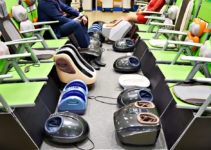How Can You Prevent Plantar Fasciitis?
You have to know what are the risk factors related to your body and lifestyle. You have to take control of those factors which are controllable. Here I’ll give you some guidelines to prevent recurrence of plantar fasciitis symptoms:
- Lose weight.If your body mass index (BMI) > 25, that means you are located in one of 4 classifications of obesity. So, this is the red alert of gaining more weight, and you have to lose the extra pounds that make more stress on the plantar fascia.
- Avoid wearing high heeled or so flat shoes.
- Avoid prolonged periods of standing or walking for long distances. Divide any prolonged activity into small parts, even if that is the nature of your occupation. Take breaks every 20-30 minutes.
- Stop doing any vigorous exercise or stretches. Avoid running for prolonged periods at once or for very long distances.
- Wearing the suitable type of Orthotics or Splints to keep your feet and ankle in an excellent normal state to decrease the stress on the plantar fascia, by using:
1. Shoe inserts (Shoe insoles)
This type of orthotics provide support for the foot arches and keep it in the best position with the least stress on the plantar fascia.
2.Heel pads (heel cups). Also called heel cushions.
This type of orthotics works like support cushion to the heel and bottom of the foot to decrease the pressure, which is loaded on the heel during different activities during the day.
3.Night splints or braces.
This type of brace is used to keep the Achilles tendon and calf muscles in the best-sustained stretch position. You can use it during the night while you are sleeping until you gain the best result and improvement of plantar fasciitis symptoms.
4.Walking boot or cast.
It’s a type of orthotics that used to protect the foot and ankle joint during walking or standing. It’s maybe more suitable in case of injury or surgery. Still, it can be used for a temporary period in some instances of plantar fasciitis.
- Kinesiology taping (physio tape). It’s a type of stretchable medical tape can be used by your physical therapist to apply it on your foot or ankle to relieve pain and decrease the stress of the plantar fascia, as it provides excellent support for the foot arches during standing, walking, running or other types of sports.
- Follow the instructions related to lifestyle and occupation from your physical therapist. Your physical therapist has a good knowledge of plantar fasciitis condition and your symptoms and about the factors that can make it worse. Make sure that you follow these instructions provided by your physical therapist, which is very important in gaining of best treatment result.
- Follow the home exercises program from your physical therapist. Home exercises program that your physical therapist teaches you is the most crucial part of the conservative medical treatment that you should follow, which will give you an excellent long-term prognosis for your condition.
Your physical therapist will teach you how to do these exercises and when to do, sets, repetition, and hold time in each repetition. Stretching and strengthening and range of motion exercises will be the most critical exercises in your physical therapy treatment plan.
Conclusion
In this article, we talked in details about all the aspects of plantar fasciitis condition to make your decision.
So after you completed reading this article, you can now make your decision about your treatment to get the best option for you.
Now it’s your turn to tell us what the treatment options you received, and that worked, and how did you deal with your case?
Let us know in the comments below.
References
- Buchbinder, R 2018, ‘Patient education: Heel and foot pain (caused by plantar fasciitis) (Beyond the Basics)’, https://www.uptodate.com/contents/search. Accessed on 15 Aug. 2019
- STEPHEN L. BARRETT, D.P.M., and ROBERT O’MALLEY, D.P.M., and ROBERT CRAWFORD, 1999, ‘Plantar Fasciitis and Other Causes of Heel Pain’, the American Academy of Family Physicians, 15;59(8), pp. 2200-2206, Accessed 15 Aug. 2019
- Mohammad A. T., Mehdi M., Mohammad N. T., Babak S., 2012, ‘Plantar fasciitis’, US National Library of Medicine National Institutes of Health Top of Form Bottom of Form, 17(8), pp 799–804, Accessed on 15 Aug. 2019
- Goff JD, and Crawford R, 2011, ‘Diagnosis and treatment of plantar fasciitis’, US National Library of Medicine National Institutes of Health, 15;84(6), pp. 676-82, Accessed 16 Aug. 2019
- PRISCILLA TU, DO, and JEFFREY R. BYTOMSKI, DO, 2011, ‘Diagnosis of Heel Pain’, the American Academy of Family Physicians, 15;84(8), pp. 909-916, Accessed 16 Aug. 2019
- Liselotte Hansen, Thøger Persson Krogh, Torkell Ellingsen, Lars Bolvig, and Ulrich Fredberg, 2018, ‘Long-Term Prognosis of Plantar Fasciitis: A 5- to 15-Year Follow-up Study of 174 Patients With Ultrasound Examination’, 6(3): 2325967118757983, Accessed 16 Aug. 2019
- Díaz López AM, Guzmán Carrasco P., 2014, ‘[Effectiveness of different physical therapy in conservative treatment of plantar fasciitis: a systematic review]’, 88(1), pp. 157-78, Accessed 12 Aug. 2019
- Al-Boloushi Z, López-Royo MP, Arian M, Gómez-Trullén EM, Herrero P, 2019, ‘Minimally invasive non-surgical management of plantar fasciitis: A systematic review‘, 23(1), pp. 122-137, Accessed 12 Aug. 2019
- Júlia Maria D’Andréa Greve, Marcus Vinicius Grecco, and Paulo Roberto Santos-Silva, 2009, ‘Comparison of Radial Shockwaves and Conventional Physiotherapy for Treating Plantar Fasciitis‘, 64(2), pp. 97–103, Accessed 12 Aug. 2019
- Sun J1, Gao F, Wang Y, Sun W, Jiang B, Li Z., 2017, ‘Extracorporeal shock wave therapy is effective in treating chronic plantar fasciitis: A meta-analysis of RCTs’, 96(15): e6621, Accessed 12 Aug. 2019
- Opeyemi O Babatunde, Amardeep Legha, Chris Littlewood, Linda S Chesterton, Martin J Thomas, Hylton B Menz, Danielle van der Windt, Edward Roddy, 2018, ‘Comparative effectiveness of treatment options for plantar heel pain: a systematic review with network meta-analysis‘, 53(3), Accessed 12 Aug. 2019
- Alshami AM, Souvlis T, Coppieters MW, 2008, ‘A review of plantar heel pain of neural origin: differential diagnosis and management‘, 13(2), pp 103-11, Accessed 21 Aug. 2019
- Monto RR, 2013, ‘Platelet-rich plasma and plantar fasciitis’, 21 (4), pp 220-4, Accessed 21 Aug. 2019
- Lareau CR, Sawyer GA, Wang JH, DiGiovanni CW, 2014, ‘Plantar and medial heel pain: diagnosis and management‘, 22 (6), pp 372-80, Accessed 21 Aug. 2019
- Thiel M, 2001, ‘Application of shock waves in medicine’, 387:18-21, Accessed 23 Aug. 2019



